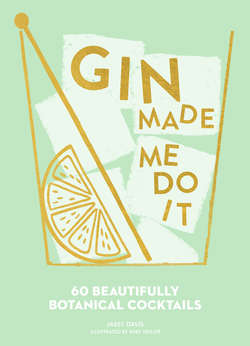Читать книгу Gin Made Me Do It: 60 Beautifully Botanical Cocktails - Ruby Taylor - Страница 7
ОглавлениеIn 1736, London gin drinkers dressed in black held a mock funeral for ‘Madame Geneva’, the spirit they loved and that they were afraid would be killed by the 1736 Gin Act. They were wrong, of course. Like Obi-Wan Kenobi, attempts to strike gin down only make it more powerful. Today the range of gins in your local bottle shop is so vast, it’s worth learning about the common styles so you can be sure to pick the perfect bottle for every occasion.
LONDON DRY GIN
The first thing you should know about London dry gin is that it doesn’t have to be made in London. London dry is a method, not a place, and it’s protected under EU law. To be a London dry gin, a grain spirit must be distilled in a traditional still with natural ingredients, and no flavourings, colour or sugar can be added once it has been distilled. It has a minimum ABV of 37.5% and juniper is the predominate flavour. Fresh, citrusy and, obviously, dry, London dry is a classic style of gin that’s perfect for mixing in G&Ts and cocktails.
NEW WESTERN DRY GIN
Also called craft gin, artisan gin, boutique gin and small-batch gin. By EU law, new western dry gins should probably be called ‘distilled gin’. They’re gins that are made in a traditional still with natural flavourings, but once they’re distilled, flavourings, additives and colourings can be added. The emphasis in new western dry gins is less on juniper and more on the other botanicals, which are often added after the gin has been distilled. Hendricks, Tanqueray No. Ten, Aviation and G Vine are all examples of new western dry. Each has its own unique flavour profile, so when you find the gin you love, keep hold of it and experiment to find the cocktails that its mix of botanicals best suits.
PLYMOUTH GIN
While London dry gins don’t have to be made in London, Plymouth gin can only be distilled in Plymouth, Devon. There’s just one distillery doing that called, naturally enough, Plymouth Gin. The distillery was established in 1793 and for 200 years it supplied gin to the British Royal Navy. After the distillery was bombed in 1941, the Navy ended the contract and the distillery had a few lean years until it was rescued by investors in 1996. The flavour is sweeter and earthier than London dry. At first sip, it’s heavy on the coriander and has a lingering spicy note of liquorice. When you’re making 19th-century navy cocktails, like Pink Gin, reach for Plymouth first.
NAVY STRENGTH GIN
In the 18th century, there was one sure way to make certain the barrels of gin being loaded onto ships contained the real thing, and hadn’t been watered down or adulterated: spill the gin on some gunpowder. If the gunpowder still lit, the gin was 114 proof, or 57% ABV as we know it now. There’s no specific flavour profile for navy strength gins. The only thing that unites them is their alcoholic strength, so try a few to find the gin that suits you. The first time you make a Gimlet, that quintessential British navy mix of gin and lime juice, make it with Plymouth navy strength.
OLD TOM GIN
The gin that bridges the gap between Dutch genevers and London dry, Old Tom gins emerged in the 18th century when London’s distillers were making gin in unreliable pot stills that produced a rough spirit. By being heavy-handed with sugar and liquorice, the distillers made their gin passable enough for London’s drinking classes. The gin renaissance has seen a few distilleries start producing Old Tom gins again and they have a malty, sweet flavour with a more muted juniper profile than London dry. Use it to make Tom Collins and Martinez cocktails.
OUDE GENEVER
The granddaddy of gin, genever can only be made in Belgium, The Netherlands and parts of France and Germany. Oude, as you may have guessed, means ‘old’. But it isn’t a barrel-aged spirit. The ‘old’ refers to the method, and oude genever is an old-style, traditional genever. That it’s juniper-scented goes without saying, but oude genevers are also 15–50% malt wine (the rest has to be a neutral grain spirit), so they have a malty flavour with a rich, viscous mouthfeel. Try it neat as a digestif, or mixed in cocktails in place of Old Tom gin, whiskey or bourbon.
JONGE GENEVER
Oude genever’s young, thrusting, more modern sibling, jonge genever was invented in the 1950s as a response to the rising popularity of vodka. Jonge genever is 15% malt wine mixed with a neutral grain spirit and it tastes more like a classic dry gin. Mix it in Negronis, Last Words and Puritans in place of London dry.
To make gin, a base spirit is distilled (usually from grains), then it is redistilled with botanicals to extract the essential oils and add flavour. Redistilling is most commonly done by the ‘steep and boil’ method, wherein a watered down base spirit is steeped with juniper and other botanicals for up to 48 hours, then distilled through a pot still and mixed with water until it hits the right ABV. The redistilling can also be done by vapourising the base spirit through the aromatics.
In a traditional pot still, the stillman has a lot of influence over the process as he or she has to make the ‘cuts’. Because different botanicals evaporate at different temperatures, the stillman has to find the moment in the process when the right mix of flavours all come together. The first runnings out of the still, called the heads, have to be cut just as the sweet-scented heart of the run begins to flow, eventually dwindling down to the tails, which also have to be cut. Knowing when to cut the gin is as much art as it is science.
